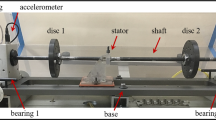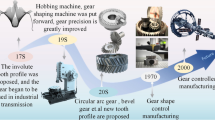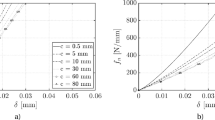Abstract
Elastic deformations of a gear body lead to deformations of the flank line of a gear and have therefore an impact on the load distribution on the flank. ISO 6336-1 Annex E proposes a calculation of the face load distribution factor taking into account shaft deflections, but a shaft calculation using a beam model cannot take into account additional deformations of the gear body. Additionally, elastic deformations of planetary gears have an impact on the load distribution of the supporting bearings.
Gear body deformations could be considered by using a full FEA calculation of the gear-body. For repeated calculations the FEA-mesh could be statically condensed on the interface nodes to reduce the degrees of freedom of the calculation model. This has some limitations as the contact point for the gear mesh can change, for example in case of a rotating planet carrier. If the contact position changes, other nodes of the FEA-mesh would be loaded, so either the full surface mesh has to be used or the condensation is repeated on change of the contact point.
For static condensation of FEA based components the MESYS shaft system calculation 10/2018 introduced a condensation to a Fourier series for gears and bearings. After condensation to the Fourier series, large rotations of the gear or changes of the contact positions can be considered without the need to redo the condensation or to include all surface nodes of the gear or bearing. The Fourier series is used in circumferential direction and an integrated Legendre polynomial is used over the face width. This approach allows the extension of a shaft system calculation for a gearbox by more accurate deformations without losing the advantages in performance compared to FEA calculations.
Like the shaft deformations in ISO 6336-1 Annex E now the deformations of the flank line including gear-body deformations can be directly used to calculate the face load factor. The effect of additional gear-body deformations can then be considered in strength or life assessment according to ISO 6336 or it can be used to determine improved flank-line corrections. In case of planetary gears, the deformation can be considered in calculation of the load distribution of the bearings.
Zusammenfassung
Elastische Verformungen von Radkörpern führen zu Flankenlinienabweichungen und haben daher einen Einfluss auf die Lastverteilung auf der Zahnflanke. ISO 6336-1 Anhang E schlägt eine Berechnung der Breitenlastverteilung unter Berücksichtigung der Biege- und Torsionsverformungen der Welle vor, allerdings kann eine Wellenberechnung auf Basis von Balkenmodellen die Verformungen von Radkörpern nicht abbilden. Elastische Verformungen von Planetenrädern haben zusätzlich einen Einfluss auf die Lastverteilung der Planetenlager.
Radkörperverformungen könnten über eine vollständige FE-Berechnung des Radkörpers berücksichtigt werden. Für wiederholte Berechnungen könnte das FE-Netz statisch auf die Schnittstellenknoten kondensiert werden, um die Anzahl Freiheitsgrade des Berechnungsmodells zu reduzieren. Dies hat Nachteile, wenn sich der Kontakt des Zahneingriffs verlagert, zum Beispiel bei einem rotierenden Planetenträger. Wenn sich die Position des Zahneingriffes verändert, werden andere Knoten belastet, daher muss entweder eine Kondensation auf das gesamte Oberflächennetz erfolgen oder die Kondensation muss aktualisiert werden.
Für die statische Kondensation FE-basierter Bauteile wurde in der MESYS Wellensystemberechnung 10/2018 eine Kondensation auf einen Fourieransatz für Wälzlager und Stirnräder eingeführt. Nach der Kondensation auf die Fourieransatz können grosse Rotationen oder eine Änderung der Eingriffsposition ohne eine erneute Kondensation berücksichtigt werden. Eine Fourierreihe wird in Umfangsrichtung verwendet während integrierte Legendrepolynome die Verformung über die Zahnbreite beschreiben Dies erlaubt die Berücksichtigung genauerer Verformungen in einer Wellensystemberechnung für Getriebe ohne die Vorteile der geringen Rechenzeiten im Vergleich zu vollständigen FE-Berechnungen zu verlieren.
Analog zu den Verformungen der Welle in ISO 6336-1 Anhang E können die Verformungen der Flankenlinie inklusive der Radkörperverformungen für die Berechnung des Breitenlastfaktors verwendet werden. Der Einfluss der zusätzlichen Radkörperverformungen kann in der Festigkeitsberechnung nach ISO 6336 oder zur Auslegung von Flankenlinienkorrekturen berücksichtigt werden. Bei Planetenrädern lässt sich die Radkörperverformung mit der Berechnung der Lastverteilung der Wälzlager koppeln.










Similar content being viewed by others
References
CM2 FEM—finite elements technical manual (2019) Computing objects. Versailles
ISO 6336-1 (2006) Calculation of load capacity of spur and helical gears—part 1: basic principles, introduction and general influence factors
ISO/DIS 6336-1 (2018) Calculation of load capacity of spur and helical gears—part 1: basic principles, introduction and general influence factors
MESYS AG (2018) MESYS Software Manual Version 10-2018. MESYS AG, Zürich
Raabe M (2019) Berücksichtigung der elastischen Gehäusedeformation auf die Lastverteilung im Wälzlager über einen Fourieransatz, VDI-Berichte Nr. 2348, VDI Verlag GmbH, Düsseldorf, pp 77–86
Weber C, Banaschek K (1953) Formänderung und Profilrücknahme bei gerad- und schrägverzahnten Rädern. Schriftenreihe Antriebstechnik. Vieweg, Braunschweig
Willberg C, Duczek S, Vivar Perez JM, Schmicker D, Gabbert U (2012) Comparison of different higher order finite element schemes for the simulation of Lamb waves. Comput Methods Appl Mech Eng. 246–261. https://doi.org/10.1016/j.cma.2012.06.011
Author information
Authors and Affiliations
Corresponding author
Rights and permissions
About this article
Cite this article
Raabe, M. Consideration of elastic deformations of gear bodies using a reduction on a Fourier series. Forsch Ingenieurwes 83, 461–468 (2019). https://doi.org/10.1007/s10010-019-00362-5
Received:
Accepted:
Published:
Issue Date:
DOI: https://doi.org/10.1007/s10010-019-00362-5




